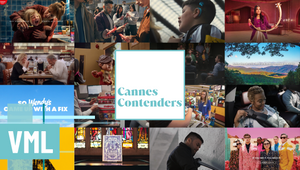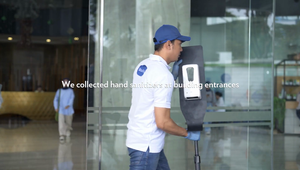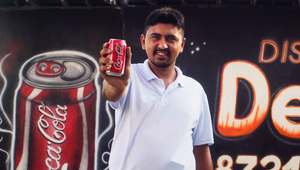
Creativity Squared: Natxo Díaz on Igniting Disruptive Thinking

Natxo is a leading creative director passionate about the industry work, creative technology and business transformation. As global head of craft he is responsible for all health creative execution and craft for VML Health across all territories. He is member of the global executive creative board for VML Health and member of the EMEA executive creative board for VML.
I consider myself a curious guy. I guess that’s probably obvious for any creative, but I feel that finding curious minds in our industry is not as common as it should be nowadays. I like to remind our younger creatives that if they are not curious about things around them, their work won’t be as special or different as someone with an exploring mind. Exploring minds are more likely to land in uncommon places. Curiosity is one of the most important soft skills a creative can have today, as is humility.
I don’t think creativity is 100% innate, but I believe that creativity is the result of the person one is. If we close our eyes to the things the world has to show us, we’ll miss many sources of inspiration and small, but important details and nuances in what we see. These details ignite disruptive thinking. This is something that young creative students won’t necessarily learn at school.
When you are curious, you also tend to consume a lot of industry work. And that’s key to improve your skills as a creative. I spend hours digging into LoveTheWork and other creative archives to see what the industry is doing. I love to learn and get inspiration from other industries, markets, cultures, and disciplines. I love to get inspiration from sources that aren’t close to the work we usually do in our agency. Learning from unusual places helps us keep evolving.
The first thing I usually look for in a great piece of work is the big idea and the insight behind it. Once I’ve evaluated the big idea, I look at its craft — the way it’s executed. When there’s something special in both aspects, that project automatically takes my attention. Last but not least, I look for the impact of the idea. It doesn’t matter if you have the most creative idea in the world — it has to make an impact and improve outcomes for your audiences. These are the three boxes any idea must make to shine.
I have to admit, I have a special connection to innovation — a new product or something that uses an ad medium in a new way. These themes take on a vital importance when you work in health. Health is an industry where solutions that transcend advertising can really have a huge impact in people’s lives. Creative ideas in health can help our clients go beyond treatments and even reach areas HCPs cannot get to.
Our project Dogs Without Borders is an example of this kind of solution. Rescuing abandoned dogs and training them to sniff out cancer (and other diseases) in remote communities helps people access diagnoses and seek out life-saving treatment. This innovative, sustainable, and scalable solution has become an independent NGO and recently has been officially incorporated into Brazil’s national health system for breast cancer screening in remote areas.
The most successful ideas explore universal truths. They are based on global insights that revolve around common themes that most of us can easily engage with. They are ideas that we identify with that make us feel connected and represented. When an idea gets through these paces, it’s usually a huge success.

I don’t really like to talk about a specific process when talking about creative processes. Of course, there are different proven methods and techniques to produce ideas or to create in general. But if I’m honest, I think that the most important thing is a creative culture in the agency. A culture where every employee can breathe freely from the very first moment they get into the office. This matters to everyone — even if you are not working in the creative department.
Many people think that the most successful creative agencies in the world have the most talented creative teams. Of course that’s very important, but what really makes the difference is when an agency places creativity at the core of every part of the process — in every department. Creativity should be much more than just a person or a department. It’s a collaborative and connected process the whole agency is responsible for building and elevating.
You can have the most talented and awarded creative leader and teams in the world, but if your agency’s culture does not truly embrace creativity as a distinct value, then it won’t be able to create great work.
Of course, if you check some of the most successful campaigns, you can find a formula to apply to your campaign while you are crafting it. However, if we go to the very first stage of an idea, where you must select the idea itself, sometimes you find different good and valid approaches — and at some point, you need a leap of faith. In that moment, I like to listen to my gut feeling. You can worry about failing, but I’ve regretted not following my gut many more times than following it.
While executing the campaign, there are only three things that really make a difference: investing BIG in craft, finding the best partners for producing and spreading it, and paying attention to every detail throughout the process. It seems obvious and easy, but it’s the hardest thing to do. If it wasn’t, all the agencies would be winning big on the awards circuit.
When I was a kid, I used to spend a lot of time with my grandfather. He was an engineer who loved to work on handyman jobs and inventions. Some of them were brilliant, others not so much, but the important thing was that he shared his curiosity and fascination for trying new things. Changing the angle to see things differently and find new ways of doing things. I’m quite sure I wouldn’t be who I am today if it wasn’t for him. He gave me a passion to explore, to read and to try new things.
I also wouldn’t be the creative person I am today if my mum hadn’t instilled some important values — ones I try to always keep close. I like to think of them as my personal flag that I bring to every project I join: humility, listening, effort and consistency.
These four values are key to work as a creative. Through them, it’s easy to remember that you’re not always right and how important it is to treat people with respect, to make sure everyone has a voice — and then to listen to what they have to say. Don’t give up when you have those moments when it might feel like the project will fail or won’t happen. Understand that most of the greatest ideas are a long-distance race, not a sprint, and last but not least, always be eager to start a new big project, even before the last one ends.
If I had to give advice to clients, I would tell them to partner with an agency that has people who inspire them. (Just like my grandfather inspired me.) I would tell them to trust their work and believe in their gut feeling until the end. To make sure they have room to be creative — and to avoid (if possible) the stressful rigid deadlines and always try to invest the most they can in craft, as it makes the difference. If they can do that — and that is a big ask — the work will reach new heights.















